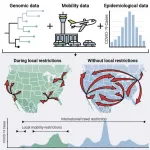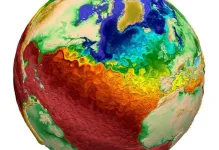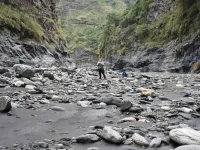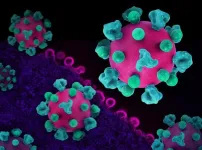(Press-News.org) LA JOLLA, CA—Elucidating human contact networks could help predict and prevent the transmission of SARS-CoV-2 and future pandemic threats. A new study from Scripps Research scientists and collaborators points to which public health protocols worked to mitigate the spread of COVID-19—and which ones didn’t.
In the study, published online in Cell on December 14, 2023, the Scripps Research-led team of scientists investigated the efficacy of different mandates—including stay-at-home measures, social distancing and travel restrictions—at preventing local and regional transmission during different phases of the COVID-19 pandemic. They found that local transmission was driven by the amount of travel between locations, not by how geographically nearby they were. The study also revealed that the partial closure of the U.S.-Mexico border was ineffective at preventing cross-border transmission of the virus. These findings, in combination with ongoing genomic surveillance, could help guide public health policy to prevent future pandemics and mitigate the new “endemic” phase of COVID-19.
“We show that it’s not necessarily how geographically close locations are to each other; the real measure is how connected two locations are in terms of the movement of people,” says co-senior author Mark Zeller, PhD, a project scientist and genomic epidemiologist in Kristian Andersen’s lab at Scripps Research. “SARS-CoV-2 is probably a good model for respiratory virus spread in general, and knowing how these viruses are spreading can help us develop targeted measures for future pandemics.”
The study was led by Scripps Research scientists in collaboration with the County of San Diego, UCSD and various academic laboratories, public health laboratories and hospitals in California and Baja California, Mexico.
“This invaluable information helps direct strategies to mitigate the spread of future viral threats—including our ongoing genomic surveillance methods, such as wastewater testing,” says Seema Shah, MD, medical director of San Diego County’s epidemiology and immunization services branch. “In an era where global challenges require united responses, this study is also a testament to the close-knit collaboration between academic research institutions and public health laboratories and hospitals on both sides of the border.”
To explain how changing travel patterns impacted COVID-19 transmission during the first two years of the pandemic, the team quantified the genetic similarity between viral sequences collected at different locations and points in time.
“The more similar the virus genomes are between two different locations, the more connected those locations are in terms of the movement of people,” says Zeller.
The researchers sequenced more than 82,000 SARS-CoV-2 samples from San Diego, California and Baja California, Mexico and compared these sequences to SARS-CoV-2 genomes from North America and the rest of the world. Then they integrated the genomic data with a database of air and land travel data (based on anonymous cellphone tracking) to estimate the connectivity of different counties within North America.
During the early phases of the pandemic, when COVID-19 mandates included strict stay-at-home and social distancing measures, transmission mainly occurred at the local and regional level—within and between neighboring counties. But as these mandates were relaxed and people began to travel more freely, predictably, transmission from distant locations increased.
“Mobility between neighboring counties remained almost constant throughout the entire first two years of the pandemic, but it was these long-distance movements, from San Diego to more distant counties or to neighboring states, that were really disrupted by the early mandates,” says genomic epidemiologist and first author Nathaniel Matteson, PhD, who worked on the study as a graduate student in the Andersen Lab at Scripps Research. “After the mandates were relaxed, about 50% of the virus circulating in San Diego was the result of locally circulating virus, and 50% had been recently introduced as the result of travel between locations.”
The analysis also revealed there was continuous transmission between San Diego and nearby Baja California during the entire duration of the pandemic, suggesting that the partial closure of the U.S.-Mexico border was ineffective in preventing transmission.
“This finding adds to this growing body of evidence that these targeted measures that try to stop the flow of people from one specific location are quite ineffective, whereas social distancing measures have shown to be much more effective at reducing transmission,” says Matteson. “It also highlights the importance of regional and international collaborations and resource sharing for effective disease surveillance and prevention.”
Next, the researchers plan to study transmission dynamics at an even finer scale. “Now we’re looking at hyper-local transmission within San Diego County—for example how transmission is influenced by things like commuting patterns,” says Zeller.
In addition to Zeller and Matteson, authors of the study, “Genomic surveillance reveals dynamic shifts in the connectivity of COVID-19 epidemics,” include Ezra Kurzban, Madison A. Schwab, Sarah A. Perkins, Karthik Gangavarapu, Joshua I. Levy, Edyth Parker, Manuel Sanchez-Alavez, Alana Weiss, Catelyn Anderson, Christine M. Aceves, Emily G. Spencer, Alison J. King, Emory C. Hufbauer, Justin J. Lee, Karthik S. Ramesh, Kelly N. Nguyen, Kieran Saucedo, Refugio Robles-Sikisaka, Laura Nicholson, Kristian G. Andersen, and Shirlee Wohl of Scripps Research.
This work was supported by funding from the National Institutes of Health (U19AI135995, U01AI151812, UL1TR002550, F32AI154824, and R01AI153044), The Prebys Foundation, and the CDC contract 7530122C14843. Computing resources for this research were donated by NVIDIA Corporation and Advanced Micro Devices, Inc.
About Scripps Research
Scripps Research is an independent, nonprofit biomedical institute ranked one of the most influential in the world for its impact on innovation by Nature Index. We are advancing human health through profound discoveries that address pressing medical concerns around the globe. Our drug discovery and development division, Calibr, works hand-in-hand with scientists across disciplines to bring new medicines to patients as quickly and efficiently as possible, while teams at Scripps Research Translational Institute harness genomics, digital medicine and cutting-edge informatics to understand individual health and render more effective healthcare. Scripps Research also trains the next generation of leading scientists at our Skaggs Graduate School, consistently named among the top 10 US programs for chemistry and biological sciences. Learn more at www.scripps.edu.
END
Social distancing was more effective at preventing local COVID-19 transmission than international border closures
Scripps Research scientists and collaborators uncovered the relative effectiveness of different COVID-19 mandates, helping guide public health policy for future viral threats.
2023-12-14
ELSE PRESS RELEASES FROM THIS DATE:
Custom software speeds up, stabilizes high-profile ocean model
2023-12-14
On the beach, ocean waves provide soothing white noise. But in scientific laboratories, they play a key role in weather forecasting and climate research. Along with the atmosphere, the ocean is typically one of the largest and most computationally demanding components of Earth system models like the Department of Energy’s Energy Exascale Earth System Model, or E3SM.
Most modern ocean models focus on two categories of waves: a barotropic system, which has a fast wave propagation speed, and a baroclinic system, which ...
Can you change a chicken into a frog, a fish or a chameleon?
2023-12-14
Gastrulation is one of the most important phases in early embryonic development. Before gastrulation, vertebrate embryos are simple two-dimensional sheets of cells. By the end of gastrulation, an embryo will have begun to differentiate distinct cell types, set up the basic axes of the body and internalize some of the precursors for organs in a three-dimensional structure. Amniotes, like chickens and humans, will have developed a primitive streak, the precursor to the brain and skin, while fish and amphibians will have developed a spherical-shaped ...
How the immune system fights to keep herpes at bay
2023-12-14
Herpes simplex virus (HSV) is extremely common, affecting nearly two-thirds of the world’s population, according to the World Health Organization.
Once inside the body, HSV establishes a latent infection that periodically awakens, causing painful blisters on the skin, typically around the nose and mouth. While a mere nuisance for most people, HSV can also lead to dangerous eye infections and brain inflammation in some people and cause life-threatening infections in newborns.
Researchers have long known ...
Drones capture new clues about how water shapes mountain ranges over time
2023-12-14
UNIVERSITY PARK, Pa. — Drones flying along miles of rivers in the steep, mountainous terrain of central Taiwan and mapping the rock properties have revealed new clues about how water helps shape mountains over geological time, according to a team led by Penn State scientists.
The researchers found a link between the size of boulders in the rivers and the steepness of the rivers. The link shows how rock properties can influence the relationship between tectonic processes happening deep underground and how mountainous landscapes ...
NIH research identifies opportunities to improve future HIV vaccine candidates
2023-12-14
WHAT:
An effective HIV vaccine may need to prompt strong responses from immune cells called CD8+ T cells to protect people from acquiring HIV, according to a new study from researchers at the National Institute of Allergy and Infectious Diseases (NIAID), part of the National Institutes of Health, and colleagues. The study findings, appearing in Science, draw comparisons between the immune system activity of past HIV vaccine study participants and people with HIV who naturally keep the virus from replicating even in the absence of antiretroviral ...
Can an app improve your romantic relationship?
2023-12-14
Half of all marriages in the United States are likely to fail by the time the spouses reach their 50s. Understandably, many couples are looking for ways to avoid becoming part of that statistic, well aware of a divorce’s possible wide-reaching detrimental effects on families, children, personal finances, individual well-being—and direct and indirect costs to society.
Ronald Rogge, an associate professor of psychology at the University of Rochester, has been researching the complex dynamics ...
Climate-smart ocean planning in Antarctica awarded with 1.5M€ ERC starting grant
2023-12-14
Catarina Frazão Santos, researcher at the Faculty of Sciences of the University of Lisbon (Portugal) (Ciências ULisboa), has been awarded by the European Research Council (ERC) with a Starting Grant of approximately 1.5 million euros to study the benefits and challenges of developing sustainable, equitable and climate-smart marine spatial planning processes in Antarctica and beyond.
“We need to raise awareness and foster a ‘paradigm shift’ on how to plan for sustainability and equity in a changing ocean,” says Catarina ...
Researchers, Coast Salish people analyze 160-year-old indigenous dog pelt in the Smithsonian’s collection
2023-12-14
Researchers from the Smithsonian’s National Museum of Natural History led a new analysis that sheds light on the ancestry and genetics of woolly dogs, a now extinct breed of dog that was a fixture of Indigenous Coast Salish communities in the Pacific Northwest for millennia. Anthropologist Logan Kistler and evolutionary molecular biologist Audrey Lin analyzed genetic clues preserved in the pelt of “Mutton,” the only known woolly dog fleece in the world, to pinpoint the genes responsible for their ...
Diverse gut bacteria communities protect against harmful pathogens by nutrient blocking
2023-12-14
UNDER EMBARGO UNTIL 19:00 GMT / 14:00 ET THURSDAY 14 DECEMBER 2023
Diverse gut bacteria communities protect against harmful pathogens by nutrient blocking
New study demonstrates that diverse communities of resident bacteria can protect the human gut from disease-causing microorganisms.
However, this protective effect is lost when only single species of gut bacteria are present.
The researchers found that protective communities block the growth of harmful pathogens by consuming nutrients that the pathogen needs.
The findings, published today in the journal Science, could help to develop new strategies to optimise gut health.
The ...
Astronomers discover first population of binary stripped stars
2023-12-14
Astronomers at the University of Toronto have discovered a population of massive stars that have been stripped of their hydrogen envelopes by their companions in binary systems. The findings, published today in Science, shed light on the hot helium stars that are believed to be the origins of hydrogen-poor core-collapse supernovae and neutron star mergers.
For over a decade, scientists have theorized that approximately one in three massive stars are stripped of their hydrogen envelope in binary systems. Yet, until now, only one possible candidate had been identified.
“This was such a big, glaring hole,” says co-lead author ...
LAST 30 PRESS RELEASES:
Discovery of a new superfluid phase in non-Hermitian quantum systems
Codes in the cilia: New study maps how Cilk1 and Hedgehog levels sculpt tooth architecture
Chonnam National University researchers develop novel virtual sensor grid method for low-cost, yet robust, infrastructure monitoring
Expanded school-based program linked to lower youth tobacco use rates in California
TV depictions of Hands-Only CPR are often misleading
What TV gets wrong about CPR—and why it matters for saving lives
New study: How weight loss benefits the health of your fat tissue
Astronomers surprised by mysterious shock wave around dead star
‘Death by a thousand cuts’: Young galaxy ran out of fuel as black hole choked off supplies
Glow with the flow: Implanted 'living skin' lights up to signal health changes
Compressed data technique enables pangenomics at scale
How brain waves shape our sense of self
Whole-genome sequencing may optimize PARP inhibitor use
Like alcohol units, but for cannabis – experts define safer limits
DNA testing of colorectal polyps improves insight into hereditary risks
Researchers uncover axonal protein synthesis defect in ALS
Why are men more likely to develop multiple myeloma than women?
Smartphone-based interventions show promise for reducing alcohol and cannabis use: New research
How do health care professionals determine eligibility for MAiD?
Microplastics detected in rural woodland
JULAC and Taylor & Francis sign open access agreement to boost the impact of Hong Kong research
Protecting older male athletes’ heart health
KAIST proposes AI-driven strategy to solve long-standing mystery of gene function
Eye for trouble: Automated counting for chromosome issues under the microscope
The vast majority of US rivers lack any protections from human activities, new research finds
Ultrasound-responsive in situ antigen "nanocatchers" open a new paradigm for personalized tumor immunotherapy
Environmental “superbugs” in our rivers and soils: new one health review warns of growing antimicrobial resistance crisis
Triple threat in greenhouse farming: how heavy metals, microplastics, and antibiotic resistance genes unite to challenge sustainable food production
Earthworms turn manure into a powerful tool against antibiotic resistance
AI turns water into an early warning network for hidden biological pollutants
[Press-News.org] Social distancing was more effective at preventing local COVID-19 transmission than international border closuresScripps Research scientists and collaborators uncovered the relative effectiveness of different COVID-19 mandates, helping guide public health policy for future viral threats.







